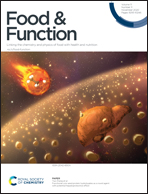Factors impacting lipid digestion and nutraceutical bioaccessibility assessed by standardized gastrointestinal model (INFOGEST): oil
Abstract
The oil droplets in commercial emulsified foods have dimensions that vary widely, from hundreds of nanometers to tens of micrometers. Previously, the size of the droplets in oil-in-water emulsions has been shown to impact their gastrointestinal behavior, which may influence their physiological effects. In this study, we analyzed the impact of oil droplet diameter (0.16, 1.1 and 8.2 μm) on lipid digestion and nutraceutical bioaccessibility using a widely used standardized gastrointestinal tract model: the INFOGEST method. The emulsions used consisted of corn oil droplets stabilized using a food-grade non-ionic surfactant (Tween 20), and the droplet size was controlled by preparing them with a microfluidizer (small), sonicator (medium), or high-shear blender (large). The surfactant-coated oil droplets were relatively resistant to size changes in the mouth and stomach, due to the strong surface activity and steric stabilization mechanism of the non-ionic surfactant used. As expected, the kinetics of lipid digestion were enhanced for smaller droplets because of their greater specific surface area. The degree of lipid digestion fell from 117% to 78% (p < 0.001) as the initial droplet diameter was raised from 0.16 to 8.2 μm. In addition, there was a reduction in β-carotene bioaccessibility from 83 to 15% (p < 0.001) with increasing droplet diameter. This result was ascribed to several effects: (i) some carotenoids were trapped inside the undigested oil phase; (ii) fewer mixed micelles were produced to internalize the carotenoids; and, (iii) a fraction of the carotenoids crystallized and sedimented. Our results underline the critical importance of considering droplet size when developing emulsified foods loaded with carotenoids. The results obtained by the INFOGEST method are consistent with those found using other in vitro methods in earlier studies.



 Please wait while we load your content...
Please wait while we load your content...